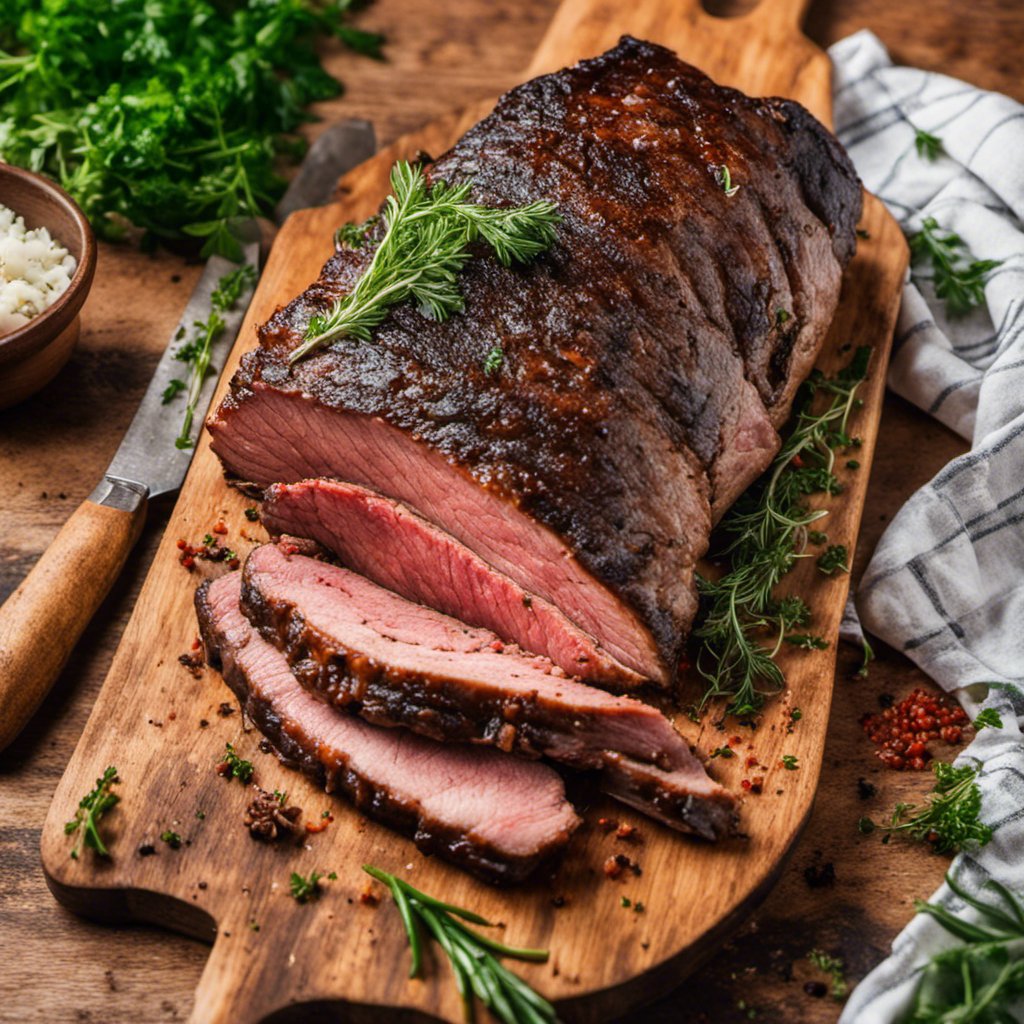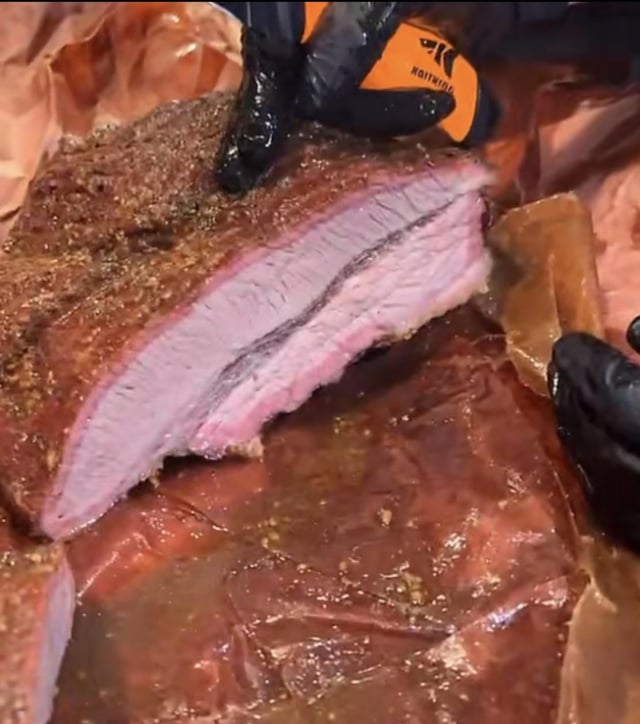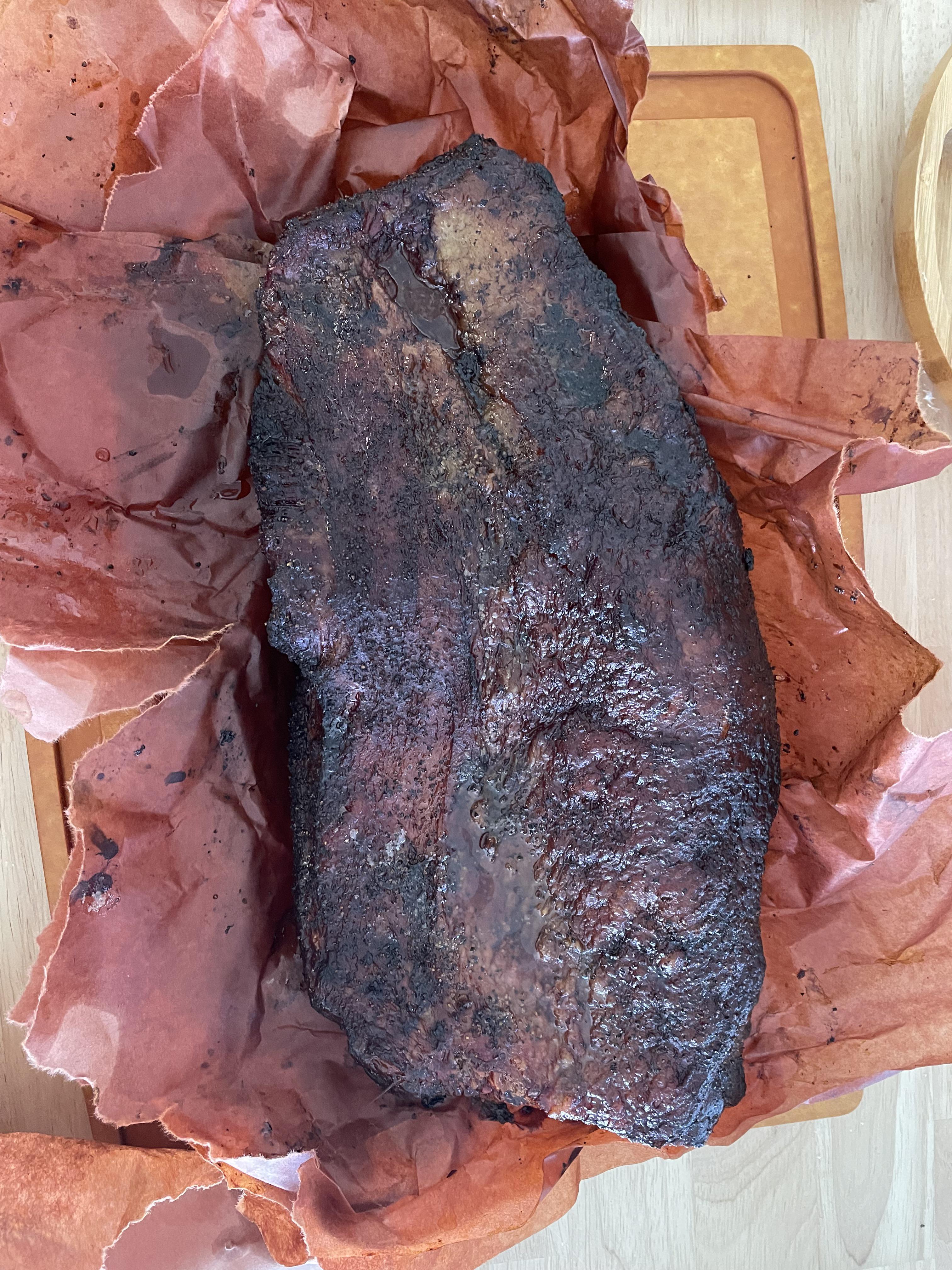
Introduction To Brisket Troubleshooting
Understanding The Common Issue Of Tough Brisket
One of the most common issues that can arise when cooking brisket is ending up with a tough and chewy piece of meat. This can be quite disappointing, especially if you’ve put in a lot of effort and time into smoking or barbecuing the brisket. However, it’s important to remember that even experienced chefs occasionally face this problem. The key is to identify the causes of tough brisket and find ways to rectify it. There are usually three main causes of tough brisket: connective tissue, fat and marbling, and undercooking.
- Connective tissue: Brisket is made up of tough connective tissues, which can be difficult to break down during the cooking process. If not cooked properly, these tissues can result in a tough texture.
- Fat and marbling: Fat and marbling contribute to the flavor and tenderness of the brisket. However, if there is too much fat or insufficient marbling, the meat can become tough and dry.
- Undercooking: Brisket requires slow and low cooking to break down the collagen in the connective tissues. If it is not cooked for a sufficient amount of time, the collagen will not fully break down, resulting in a tough texture.
The Importance Of Proper Cooking Techniques
To fix a tough brisket, it is essential to employ proper cooking techniques. Here are some methods that can help salvage a tough brisket and make it delicious:
- Low and slow cooking: Slow cooking at a low temperature allows the connective tissues to gradually break down, resulting in a tender and flavorful brisket.
- Moisture retention: Wrapping the brisket in foil or butcher paper during the cooking process can help retain moisture and prevent drying out.
- Resting period: Allowing the brisket to rest after cooking for a sufficient amount of time helps the meat reabsorb juices and become more tender.
- Slicing against the grain: Ensure you slice the brisket against the grain to shorten the muscle fibers and make it more tender.
- Marinades and injections: Using marinades or injections can enhance the flavor and tenderness of the brisket.
In conclusion, understanding the common causes of tough brisket and implementing proper cooking techniques are key to fixing this issue. With a little knowledge and practice, you can turn a tough brisket into a tender and delicious meal.
Introduction To Brisket Troubleshooting
Understanding The Common Issue Of Tough Brisket
One of the most common issues that can arise when cooking brisket is ending up with a tough and chewy piece of meat. This can be quite disappointing, especially if a lot of effort and time has been put into smoking or barbecuing the brisket. However, even experienced chefs occasionally face this problem. The key is to identify the causes of tough brisket and find ways to rectify it. The main causes of tough brisket are connective tissue, fat and marbling, and undercooking.
- Connective tissue: Brisket is made up of tough connective tissues, which can be difficult to break down during the cooking process. If not cooked properly, these tissues can result in a tough texture.
- Fat and marbling: Fat and marbling contribute to the flavor and tenderness of the brisket. However, if there is too much fat or insufficient marbling, the meat can become tough and dry.
- Undercooking: Brisket requires slow and low cooking to break down the collagen in the connective tissues. If it is not cooked for a sufficient amount of time, the collagen will not fully break down, resulting in a tough texture.
The Importance Of Proper Cooking Techniques
To fix a tough brisket, it is essential to employ proper cooking techniques. Here are some methods that can help salvage a tough brisket and make it delicious:
- Low and slow cooking: Slow cooking at a low temperature allows the connective tissues to gradually break down, resulting in a tender and flavorful brisket.
- Moisture retention: Wrapping the brisket in foil or butcher paper during the cooking process can help retain moisture and prevent drying out.
- Resting period: Allowing the brisket to rest after cooking for a sufficient amount of time helps the meat reabsorb juices and become more tender.
- Slicing against the grain: Ensure you slice the brisket against the grain to shorten the muscle fibers and make it more tender.
- Marinades and injections: Using marinades or injections can enhance the flavor and tenderness of the brisket.
Not Choosing The Right Cut
Differentiating Between The Flat And Point Muscles
When it comes to choosing the right cut of brisket, it’s important to understand the differences between the flat and point muscles. The flat muscle, also known as the “first cut” or “thin cut,” is generally leaner and less marbled compared to the point muscle. The point muscle, also known as the “second cut” or “deckle,” is fattier and more marbled. These two muscles have different textures and flavors, so it’s important to know which one is best for your desired outcome.
Best Cuts For Tender And Juicy Brisket
For a tender and juicy brisket, it is recommended to choose a well-marbled cut, such as the point muscle. This marbling helps to keep the meat moist during the long cooking process, preventing it from drying out. On the other hand, if you pick up a Select grade brisket, which is generally leaner, it may not hold up over the long cooking process and can taste dry in the end. Therefore, selecting the right cut of brisket is crucial for achieving a mouth-watering, melt-in-your-mouth smoked meat.
By understanding the common causes of tough brisket and implementing proper cooking techniques, such as low and slow cooking, moisture retention, resting, slicing against the grain, and using marinades or injections, it is possible to turn a tough brisket into a tender and delicious meal.
Cooking At The Wrong Temperature
Effects Of High And Low Temperatures On Brisket Texture
Cooking brisket at the wrong temperature can have a significant impact on the texture of the meat. Both high and low temperatures can lead to undesirable results:
- High temperature: Cooking brisket at a high temperature can cause the meat to become dry and tough. The high heat can cause the connective tissues to tighten up and become less tender.
- Low temperature: On the other hand, cooking brisket at a low temperature for too long can result in a mushy texture. The collagen in the connective tissues can break down excessively, causing the meat to lose structure and become soft and mushy.
Optimal Temperature Ranges For Smoking Brisket
Finding the right temperature range for smoking brisket is crucial for achieving a tender and flavorful result. While there may be a wide range of recommended temperatures, a general guideline is to aim for a cooking temperature range of 195-205°F (90-96°C).
Here are some considerations when it comes to temperature:
| Temperature Range | Effect on Brisket |
|---|---|
| 195-205°F (90-96°C) | This temperature range allows the connective tissues to break down slowly, resulting in a tender and juicy brisket. |
| Below 195°F (90°C) | Cooking at a lower temperature can lead to a longer cooking time, but it may result in a more tender brisket. |
| Above 205°F (96°C) | Exceeding this temperature range can cause the brisket to become dry and less tender. |
It is important to note that the internal temperature of the brisket should be monitored, but it is not the sole determinant of doneness. Factors such as connective tissue breakdown and overall tenderness should also be considered. By using temperature as a guide and taking into account other cooking techniques, such as low and slow cooking, moisture retention, and resting, it is possible to achieve a perfectly cooked, tender, and delicious brisket.

Insufficient Resting Time
The Role Of Resting In Enhancing Tenderness
Resting is a critical step in the barbecue process as it allows the brisket to retain its juices and become more tender. When the brisket is cooked, the heat causes the moisture to move towards the center of the meat. By allowing the brisket to rest, the juices have the opportunity to redistribute throughout the meat, resulting in a juicier and more flavorful final product.
Without proper resting time, the brisket may end up being tough and dry. When you slice into the brisket immediately after cooking, the juices will escape, leaving the meat dehydrated. Additionally, the muscle fibers of the brisket need time to relax and reabsorb the moisture, which contributes to its tenderness.
Recommended Resting Time For Brisket
The amount of time needed for resting can vary depending on the size of the brisket. As a general guideline, it is advisable to rest the brisket for at least one hour. However, for larger cuts of meat like a brisket, a longer resting time is often recommended to ensure optimal tenderness.
Some pitmasters suggest resting the brisket for up to two hours or even longer. This extended resting period allows the meat to fully reabsorb its juices and reach its desired level of tenderness. The exact resting time will also depend on personal preference, as some individuals may prefer a firmer texture, while others may prefer a more melt-in-your-mouth tenderness.
In conclusion, giving the brisket sufficient resting time is crucial for achieving a tender and flavorful result. The resting period allows the meat’s juices to redistribute and reabsorb, resulting in a juicier final product. It is recommended to rest the brisket for at least one hour, with longer resting times often yielding even better results. By following these guidelines, you can ensure that your brisket is perfectly cooked and enjoyed by all.
Inadequate Seasoning And Marination
How Seasonings And Marinades Affect Brisket Texture
Seasoning and marinating are essential steps in preparing a flavorful and tender brisket. Seasonings, such as dry rubs, add texture and help develop a crusty bark on the meat. On the other hand, marinades tenderize the meat, which is crucial for achieving a juicy and tender final product.
When it comes to seasoning, it ultimately comes down to personal preference. Some individuals prefer the texture and flavor that dry rubs provide, while others enjoy the tenderness that marinades offer. However, a combination of both techniques can also be used to enhance the overall taste and texture of the brisket.
Tips For Properly Seasoning And Marinating Brisket
To ensure that your brisket is properly seasoned and marinated, consider the following tips:
- Choose high-quality seasonings and marinades that complement the flavor of the brisket.
- For dry rubs, generously coat the brisket with the seasoning mixture, making sure to evenly distribute it on all sides.
- If using a marinade, allow the brisket to marinate in the refrigerator for a sufficient amount of time. This allows the flavors to penetrate the meat and tenderize it. Overnight marination is often recommended for maximum flavor and tenderness.
- Consider injecting the brisket with marinade for an even distribution of flavor throughout the meat.
- Before cooking, allow the brisket to come to room temperature. This ensures more even cooking and better flavor development.
By properly seasoning and marinating your brisket, you can enhance its taste, texture, and tenderness. Whether you choose to use dry rubs, marinades, or a combination of both, ensure that the brisket is generously coated and given enough time to absorb the flavors. With the right seasoning and marination, you’ll be able to create a mouthwatering brisket that will be enjoyed by all.
Improper Trimming
Trimming Fat And Silver Skin For Optimal Tenderness
Properly trimming the fat and silver skin from a brisket is crucial for achieving optimal tenderness. Fat can add flavor, but too much fat can result in a greasy and chewy texture. Silver skin, the connective tissue on the surface of the meat, can also make the brisket tough if left untrimmed.
Guidelines For Trimming Brisket
To trim a brisket effectively, follow these guidelines:
- Start by placing the brisket on a clean cutting board, fat side up.
- Using a sharp boning knife or a brisket trimmer, carefully trim any excess fat from the top of the brisket, leaving a thin layer for flavor.
- Next, flip the brisket over, fat side down, and trim off any silver skin using a sharp knife. This will help prevent the meat from becoming tough and chewy.
- Trim the edges of the brisket to create a more uniform shape, which will allow for even cooking.
- Remove any large pockets of fat or loose meat, as they can prevent the brisket from cooking evenly.
- Make sure to remove any membrane or excess fat from the meat side of the brisket as well.
By following these guidelines, you can ensure that your brisket is properly trimmed, resulting in a more even cooking process and a tender end product. Remember, trimming a brisket takes practice, so don’t be too hard on yourself if you don’t get it perfect the first time. Take notes and learn from each experience to improve your trimming skills.

Lack Of Moisture During Cooking
Why Moisture Is Crucial For A Tender Brisket
When cooking a brisket, it is essential to maintain adequate moisture to ensure a tender and juicy final result. Moisture helps to break down the meat’s proteins, making it tender and easy to chew. Without enough moisture, the proteins can become dry and tough, resulting in a disappointing meal.
Methods To Maintain Moisture During Cooking
To prevent dryness and retain moisture in your brisket, consider the following methods:
- The use of a water pan: Placing a water pan in your smoker or oven can help create a moist environment. The water evaporates slowly, providing a consistent source of moisture during the cooking process.
- Mop or baste the brisket: Regularly basting or mopping the brisket with a flavorful liquid can help infuse moisture and enhance the overall taste. Use a basting brush or spray bottle to apply the liquid, such as broth, marinade, or a homemade basting sauce, throughout the cooking time.
- Wrap the brisket in foil or butcher paper: After a few hours of cooking, when the brisket has developed a smoky flavor, you can wrap it tightly in foil or butcher paper. This helps to retain moisture and prevent excessive evaporation. This method, often called the Texas crutch, can be especially beneficial when cooking larger briskets.
- Cook at lower temperatures: Cooking at lower temperatures for a longer period can help prevent the brisket from drying out. Lower heat allows the connective tissues to break down gradually, resulting in a tender texture. Consider using the “low and slow” method, which involves cooking the brisket at around 225-250°F (107-121°C) for several hours.
By employing these methods, you can maintain optimal moisture levels and improve the tenderness of your brisket. Experiment with different techniques to find the one that works best for you and your desired flavor profile. Remember to monitor the internal temperature of the brisket using a meat thermometer to ensure it reaches a safe cooking temperature. With practice and attention to detail, you can achieve a moist and delectable brisket every time.
Inconsistent Smoking Techniques
Factors That Contribute To Inconsistent Smoking Results
When smoking a brisket, it is common to encounter variations in flavor, texture, and tenderness due to inconsistent smoking techniques. Several factors can contribute to these inconsistencies, including:
- Uneven Cooking: Uneven cooking can occur when certain parts of the brisket cook faster than others, resulting in inconsistent texture and tenderness. This can be caused by uneven heat distribution in the smoker or grill.
- Lack of Bark: The bark, which is the flavorful and crusty exterior of the brisket, is highly sought after. However, achieving a good bark can be challenging if proper smoking techniques are not followed.
Tips For Achieving Consistent And Delicious Smoked Brisket
To overcome the issues of inconsistent smoking techniques and ensure a mouthwatering brisket every time, consider the following tips:
- Ensure proper heat distribution: To achieve even cooking, make sure your smoker or grill is evenly heated. You can use a heat diffuser or rotate the brisket during cooking to distribute the heat more evenly.
- Maintain moisture: Moisture is crucial for a tender and juicy brisket. To prevent dryness, consider using a water pan in your smoker or oven to create a moist environment. Regularly basting or mopping the brisket with a flavorful liquid can also help infuse moisture and enhance taste.
- Develop a good bark: To achieve a flavorful and crusty bark, start by seasoning the brisket with a dry rub. Smoke the brisket at a lower temperature initially to allow the rub to penetrate the meat. Then, increase the heat to develop the desired bark while continuing to cook the brisket until it reaches the desired internal temperature.
- Cook low and slow: Cooking at a low and steady temperature, usually around 225-250°F (107-121°C), allows the brisket to cook slowly, breaking down the tough connective tissues and resulting in a tender texture. This method is known as “low and slow” and is a favorite among smokers.
By following these tips, you can improve your smoking techniques and achieve consistent and delicious smoked brisket results. Experiment with different methods to find the ones that work best for you and your desired flavor profile. Remember to monitor the internal temperature of the brisket using a meat thermometer for food safety. With practice and attention to detail, you’ll be able to produce mouthwatering smoked brisket every time.
Conclusion
Recap Of The Key Factors That Can Cause Tough Brisket
In summary, tough brisket can be attributed to the presence of connective tissue, such as collagen and elastin, which requires proper cooking to break down and transform into gelatin for a tender texture.
Recommendations For Avoiding Common Mistakes And Achieving Perfect Brisket
To avoid inconsistencies in smoking techniques and achieve a delicious brisket every time, consider the following recommendations:
- Ensure proper heat distribution by evenly heating your smoker or grill.
- Maintain moisture by using a water pan or regularly basting the brisket with liquid.
- Develop a flavorful bark by seasoning the brisket with a dry rub and adjusting the temperature during smoking.
- Cook low and slow at a steady temperature of 225-250°F (107-121°C) to break down tough connective tissues.
By following these recommendations, you can improve your smoking techniques and achieve consistent and delicious results with your brisket. Remember to monitor the internal temperature of the brisket using a meat thermometer for food safety. Practice and attention to detail will help you master the art of smoking brisket.
FAQ: Why Is My Brisket Tough? Troubleshooting Brisket Woes
Q: I cooked a brisket, but it turned out tough and chewy. What went wrong?
A: There could be several reasons why your brisket turned out tough. It’s crucial to understand the factors that contribute to its tenderness to troubleshoot the issue successfully.
Q: How long should I cook a brisket for it to become tender?
A: Cooking times can vary depending on your preferred method, but generally, a brisket will take several hours to become tender. Low and slow cooking at a low temperature, around 225-250°F (107-121°C), is recommended to break down the tough connective tissues.
Q: Is choosing the right brisket important for tenderness?
A: Absolutely! The quality of the brisket you select plays a crucial role in its tenderness. Look for a well-marbled piece of meat, meaning it should have visible veins of fat running through it. This fat will render and baste the meat, keeping it moist and tender.
Q: Could I have overcooked the brisket?
A: Overcooking a brisket is one of the common mistakes that can lead to toughness. Once a brisket reaches an internal temperature of around 190-205°F (88-96°C), it should be tender and juicy. Continuing to cook it beyond this point can result in dry and tough meat.
Q: Did I not cook the brisket long enough?
A: Undercooking a brisket can also lead to toughness. The connective tissues need enough time to break down and become tender. Ensure you cook the brisket until a probe or thermometer easily slides into the meat with little resistance.
Q: Could insufficient seasoning be the cause of my tough brisket?
A: Seasoning a brisket properly is essential, but it does not directly affect its tenderness. However, a well-seasoned brisket can enhance the overall flavor and enjoyment of the meat.
Q: Did I slice the brisket incorrectly?
A: Slicing the brisket against the grain is important to prevent toughness. When carved against the grain, you create shorter and more tender meat strands. Cutting with the grain can result in chewier slices.
Q: Could the cooking method be the culprit?
A: Yes, the cooking method can contribute to tough brisket. Slow cooking methods such as smoking, braising, or using a slow cooker help break down the connective tissues and render out the fat, resulting in a more tender end result.
Q: What can I do to salvage a tough brisket?
A: If your brisket has turned out tough, you can try slicing it thinly against the grain and serving it in a flavorful sauce or barbecue rub. Alternatively, you can chop the meat and use it as an ingredient in stews, chili, or tacos where tenderizing can occur during the additional cooking process.
Remember, cooking brisket to perfection takes practice and patience. Understanding and experimenting with different techniques and factors will help troubleshoot any problems and ensure a deliciously tender result.

American Restaurant, BBQ, Smokehouse, Texas Style Barbecue serving Prime Imported Beef raised on strict diet with no hormones and no antibiotics. Smoked low and slow old school over pure imported wood fire with no gas and no electricity.